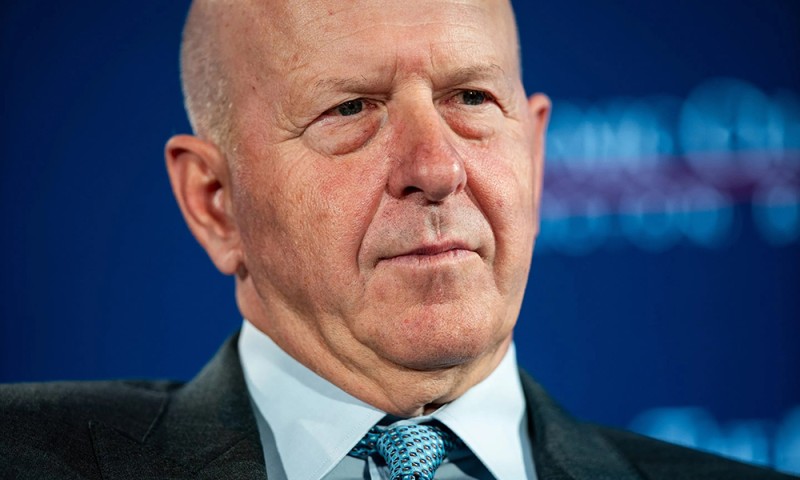
从华尔街人士到散户投资者,从常春藤盟校经济学家到美国政策制定者,几乎无人不对美国国债负担感到忧心忡忡。他们担心的是,一旦人们对债券市场的信心减弱,美国国债购买者开始质疑美国政府的偿债能力,那么后果将不堪设想。
高盛首席执行官苏德巍与摩根大通首席执行官杰米·戴蒙(Jamie Dimon)、美联储主席杰罗姆·鲍威尔(Jerome Powell)、桥水基金创始人瑞·达利欧(Ray Dalio)以及越来越多国会政客,都在担忧美国高达38万亿美元的国债问题。
事实上,和其他同行一样,苏德巍担忧的并非美国累积债务的规模,而是债务占国内生产总值(GDP)的比例。这一指标向市场传递着美国债务增速与经济增速之间的关系,进而反映其偿债能力。根据美国财政部数据,当前该比例约为125%,而美国国会预算办公室(CBO)预测,到2055年这一比例将攀升至156%。
要降低债务占国内生产总值的比例,有两种途径:要么削减开支,要么推动经济增长。后者虽被多数人视为更理想的解决方案,但这一选择可能过于乐观,未能解决财政过度扩张问题。
苏德巍指出,在当前环境下,鉴于人工智能有望推动华尔街再创新高,通过经济增长解决债务问题的可行性正日益提升。这位银行业巨擘上周在华盛顿特区经济俱乐部发表演讲时指出:“解决问题的出路在于实现增长。就解决这一问题而言,3%的复合增长率与2%的复合增长率差异极为显著,因此围绕推动实际增长的讨论颇多。”
“我认为我们具备一系列利好因素,将为实现更高增长轨迹创造有利契机,尤其是……技术、人工智能在企业中的应用,以及由此带来的生产力提升机遇,”他补充道,“但若继续沿袭当前的发展路径,而不提升经济增长水平,终将面临严峻考验。”
最新数据为苏德巍的乐观态度提供了支撑。根据美国经济分析局最新预估(因政府停摆未发布新数据,上次发布于9月25日),第二季度国内生产总值增长率达3.8%。
根深蒂固的行为模式
苏德巍(自2018年以来,一直担任高盛首席执行官)补充道,国债未必会演变成“危机”。话虽如此,但他确实表示,自己在商界的诸多人脉都对当前的债务水平,以及如今似乎已成为常态的行为感到担忧。
“我认为人们担心的是……我们已达到这样一个临界点——顺便提一句,这并非美国独有的现象,所有其他发达经济体均是如此——财政刺激和激进财政举措实际上已嵌入这些民主经济体的运行机制,而且在过去五年里,这一趋势显著加速。”他补充道。
自唐纳德·特朗普重返白宫以来,经济学家们一直强调本届政府在平衡财政收支方面采取的非常规手段。其中最主要的手段是通过加征关税来增加收入,特朗普还提议通过“黄金卡”签证计划筹集资金偿还国债,即向富裕移民收取500万美元,为其提供绿卡特权“以及入籍通道”。
特朗普在2月表示,他认为通过黄金卡计划能够彻底化解潜在债务危机,并说道:“100万张卡将带来5万亿美元收入,倘若售出1000万张,总金额将达到50万亿美元。当前债务规模为35万亿美元,这笔资金将相当可观。”
他指出,倘若售出1000万张,将产生15万亿美元“盈余”,并补充道:“这笔资金或许会用于削减赤字,但实际收益很可能远超这一数字。”(*)
译者:中慧言-王芳
从华尔街人士到散户投资者,从常春藤盟校经济学家到美国政策制定者,几乎无人不对美国国债负担感到忧心忡忡。他们担心的是,一旦人们对债券市场的信心减弱,美国国债购买者开始质疑美国政府的偿债能力,那么后果将不堪设想。
高盛首席执行官苏德巍与摩根大通首席执行官杰米·戴蒙(Jamie Dimon)、美联储主席杰罗姆·鲍威尔(Jerome Powell)、桥水基金创始人瑞·达利欧(Ray Dalio)以及越来越多国会政客,都在担忧美国高达38万亿美元的国债问题。
事实上,和其他同行一样,苏德巍担忧的并非美国累积债务的规模,而是债务占国内生产总值(GDP)的比例。这一指标向市场传递着美国债务增速与经济增速之间的关系,进而反映其偿债能力。根据美国财政部数据,当前该比例约为125%,而美国国会预算办公室(CBO)预测,到2055年这一比例将攀升至156%。
要降低债务占国内生产总值的比例,有两种途径:要么削减开支,要么推动经济增长。后者虽被多数人视为更理想的解决方案,但这一选择可能过于乐观,未能解决财政过度扩张问题。
苏德巍指出,在当前环境下,鉴于人工智能有望推动华尔街再创新高,通过经济增长解决债务问题的可行性正日益提升。这位银行业巨擘上周在华盛顿特区经济俱乐部发表演讲时指出:“解决问题的出路在于实现增长。就解决这一问题而言,3%的复合增长率与2%的复合增长率差异极为显著,因此围绕推动实际增长的讨论颇多。”
“我认为我们具备一系列利好因素,将为实现更高增长轨迹创造有利契机,尤其是……技术、人工智能在企业中的应用,以及由此带来的生产力提升机遇,”他补充道,“但若继续沿袭当前的发展路径,而不提升经济增长水平,终将面临严峻考验。”
最新数据为苏德巍的乐观态度提供了支撑。根据美国经济分析局最新预估(因政府停摆未发布新数据,上次发布于9月25日),第二季度国内生产总值增长率达3.8%。
根深蒂固的行为模式
苏德巍(自2018年以来,一直担任高盛首席执行官)补充道,国债未必会演变成“危机”。话虽如此,但他确实表示,自己在商界的诸多人脉都对当前的债务水平,以及如今似乎已成为常态的行为感到担忧。
“我认为人们担心的是……我们已达到这样一个临界点——顺便提一句,这并非美国独有的现象,所有其他发达经济体均是如此——财政刺激和激进财政举措实际上已嵌入这些民主经济体的运行机制,而且在过去五年里,这一趋势显著加速。”他补充道。
自唐纳德·特朗普重返白宫以来,经济学家们一直强调本届政府在平衡财政收支方面采取的非常规手段。其中最主要的手段是通过加征关税来增加收入,特朗普还提议通过“黄金卡”签证计划筹集资金偿还国债,即向富裕移民收取500万美元,为其提供绿卡特权“以及入籍通道”。
特朗普在2月表示,他认为通过黄金卡计划能够彻底化解潜在债务危机,并说道:“100万张卡将带来5万亿美元收入,倘若售出1000万张,总金额将达到50万亿美元。当前债务规模为35万亿美元,这笔资金将相当可观。”
他指出,倘若售出1000万张,将产生15万亿美元“盈余”,并补充道:“这笔资金或许会用于削减赤字,但实际收益很可能远超这一数字。”(*)
译者:中慧言-王芳
Between Wall Street, retail investors, Ivy League economists, and Washington policymakers, you’d be hard-pressed to find someone who isn’t nervous about America’s national debt burden. Their concern is for the day when confidence in the bond market wanes, when buyers of America’s borrowing question whether Uncle Sam can really pay his debts.
Goldman Sachs CEO David Solomon is among those concerned about the $38 trillion national debt problem, joining the ranks of JPMorgan CEO Jamie Dimon, Fed chair Jerome Powell, Bridgewater Associates founder Ray Dalio, and increasingly, politicians on Capitol Hill.
Indeed, like his counterparts, Solomon isn’t necessarily worried about the value of the debt America has accumulated, but rather its debt-to-GDP ratio. This barometer indicates to the market how much the U.S. is adding to its debt obligations in relation to how quickly its economy is growing—and thus its ability to pay back the loans. At present, that balance sits at around 125% according to Treasury data, but is expected to hit 156% by 2055, according to the Congressional Budget Office (CBO).
The balance of debt to GDP presents two options to reduce the benchmark: either cutting spending or growing the economy. The latter is seen as preferable by many, but potentially an optimistic choice that doesn’t address the problem of fiscal overstretch.
Solomon said, in the current environment, with the promise of AI boosting Wall Street to new highs, the growth option is looking more and more realistic. Speaking at the Economic Club of Washington, D.C. last week, the banking titan noted: “The path out is a growth path. The difference between compounding growth of 3% and 2% is monstrous in terms of dealing with this issue, so there’s a lot of discussion about running … real growth play.
“I think we have some things that are going to give us a better opportunity to have a higher growth trajectory, particularly … technology, AI getting embedded into the enterprise, and the productivity opportunity from that,” he added. “But if we continue on the current course, and we don’t take the growth level up, there will be a reckoning.”
According to the latest data, there’s reason for Solomon to hope. Per the Bureau of Economic Analysis’s most recent estimates (last shared on Sept. 25 as no new releases are being shared during the government shutdown), GDP in the second quarter was up 3.8%.
An embedded behavior
Solomon, who has led Goldman Sachs since 2018, added that national debt doesn’t have to become a “crisis.” That being said, he did say many of his contacts in the business community are worried about the level of debt and the behavior that now seems to be the norm.
“I think people are worried about … the fact that we’ve reached a point—and by the way, this is true in the United States, but it’s true in every other developed economy—where … fiscal stimulus and aggressive fiscal play is really just kind of embedded in the way these democratic economies are operating, and it’s accelerated meaningfully in the last five years,” he added.
Since President Donald Trump returned to the Oval Office, economists have highlighted the unusual ways the administration is rebalancing the books. While chief among them is raising revenues through tariffs, Trump has also suggested raising funds to pay off national debt through a “gold card” visa program, which would charge wealthy immigrants $5 million for green card privileges “plus a route to citizenship.”
The president said in February he believed he could avert the potential debt crisis entirely with gold cards, saying: “A million cards would be worth $5 trillion, and if you sell 10 million of the cards that’s a total of $50 trillion. Well, we have $35 trillion in debt, so that would be nice.”
He noted he would have $15 trillion “left over” if he managed to sell 10 million cards, adding: “It may be earmarked for deficit reduction, but it actually could be more money than that.”

